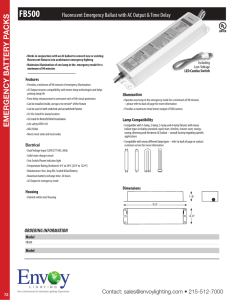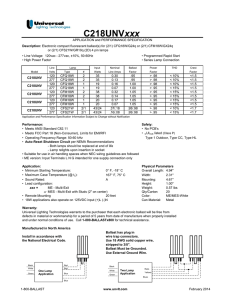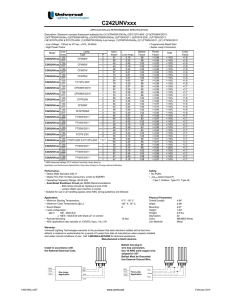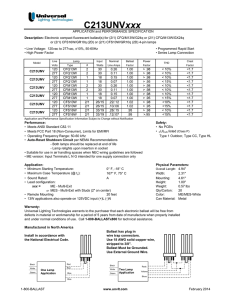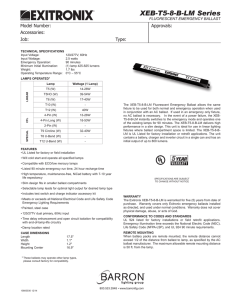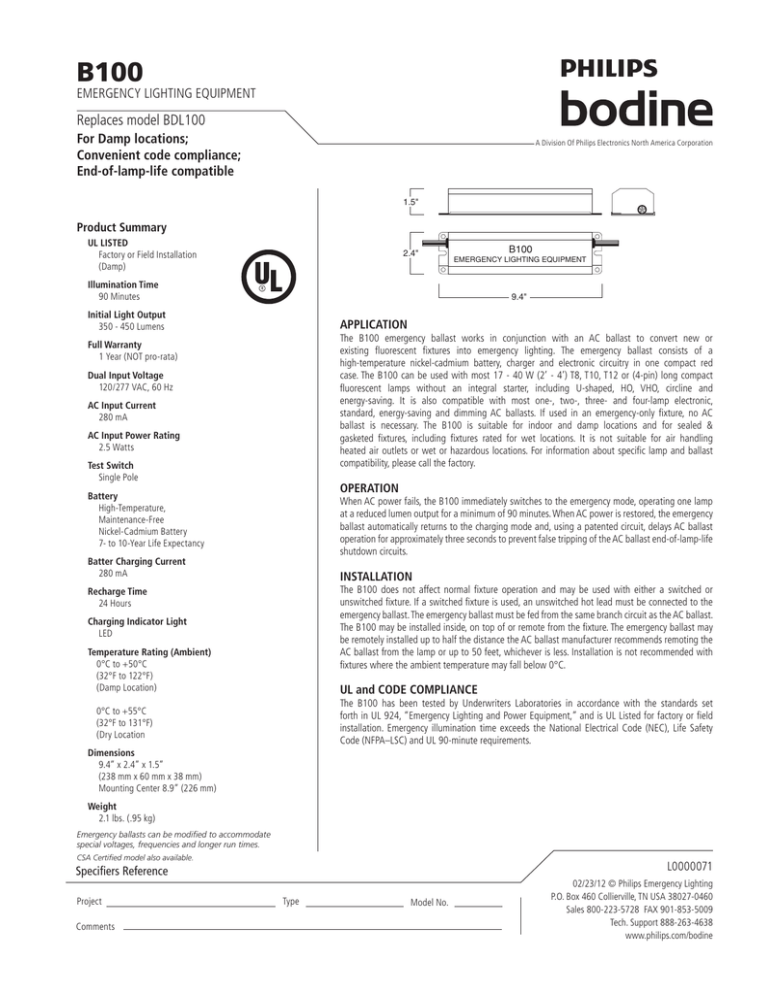
B100
EMERGENCY LIGHTING EQUIPMENT
Replaces model BDL100
For Damp locations;
Convenient code compliance;
End-of-lamp-life compatible
A Division Of Philips Electronics North America Corporation
1.5"
Product Summary
UL LISTED
Factory or Field Installation
(Damp)
2.4"
B100
EMERGENCY LIGHTING EQUIPMENT
Illumination Time
90 Minutes
9.4"
Initial Light Output
350 - 450 Lumens
APPLICATION
The B100 emergency ballast works in conjunction with an AC ballast to convert new or
existing fluorescent fixtures into emergency lighting. The emergency ballast consists of a
high-temperature nickel-cadmium battery, charger and electronic circuitry in one compact red
case. The B100 can be used with most 17 - 40 W (2’ - 4’) T8, T10, T12 or (4-pin) long compact
fluorescent lamps without an integral starter, including U-shaped, HO, VHO, circline and
energy-saving. It is also compatible with most one-, two-, three- and four-lamp electronic,
standard, energy-saving and dimming AC ballasts. If used in an emergency-only fixture, no AC
ballast is necessary. The B100 is suitable for indoor and damp locations and for sealed &
gasketed fixtures, including fixtures rated for wet locations. It is not suitable for air handling
heated air outlets or wet or hazardous locations. For information about specific lamp and ballast
compatibility, please call the factory.
Full Warranty
1 Year (NOT pro-rata)
Dual Input Voltage
120/277 VAC, 60 Hz
AC Input Current
280 mA
AC Input Power Rating
2.5 Watts
Test Switch
Single Pole
Battery
High-Temperature,
Maintenance-Free
Nickel-Cadmium Battery
7- to 10-Year Life Expectancy
Batter Charging Current
280 mA
OPERATION
When AC power fails, the B100 immediately switches to the emergency mode, operating one lamp
at a reduced lumen output for a minimum of 90 minutes. When AC power is restored, the emergency
ballast automatically returns to the charging mode and, using a patented circuit, delays AC ballast
operation for approximately three seconds to prevent false tripping of the AC ballast end-of-lamp-life
shutdown circuits.
INSTALLATION
The B100 does not affect normal fixture operation and may be used with either a switched or
unswitched fixture. If a switched fixture is used, an unswitched hot lead must be connected to the
emergency ballast. The emergency ballast must be fed from the same branch circuit as the AC ballast.
The B100 may be installed inside, on top of or remote from the fixture. The emergency ballast may
be remotely installed up to half the distance the AC ballast manufacturer recommends remoting the
AC ballast from the lamp or up to 50 feet, whichever is less. Installation is not recommended with
fixtures where the ambient temperature may fall below 0°C.
Recharge Time
24 Hours
Charging Indicator Light
LED
Temperature Rating (Ambient)
0°C to +50°C
(32°F to 122°F)
(Damp Location)
UL and CODE COMPLIANCE
The B100 has been tested by Underwriters Laboratories in accordance with the standards set
forth in UL 924, “Emergency Lighting and Power Equipment,” and is UL Listed for factory or field
installation. Emergency illumination time exceeds the National Electrical Code (NEC), Life Safety
Code (NFPA–LSC) and UL 90-minute requirements.
0°C to +55°C
(32°F to 131°F)
(Dry Location
Dimensions
9.4” x 2.4” x 1.5”
(238 mm x 60 mm x 38 mm)
Mounting Center 8.9” (226 mm)
Weight
2.1 lbs. (.95 kg)
Emergency
ballasts can be modified to accommodate
special voltages, frequencies and longer run times.
CSA Certified model also available.
L0000071
Specifiers Reference
Project
Comments
Type
Model No.
02/23/12 © Philips Emergency Lighting
P.O. Box 460 Collierville, TN USA 38027-0460
Sales 800-223-5728 FAX 901-853-5009
Tech. Support 888-263-4638
www.philips.com/bodine
B100
EMERGENCY LIGHTING EQUIPMENT
Replaces model BDL100
For damp locations;
Convenient code compliance;
End-of-lamp-life compatible
EMERGENCY ILLUMINATION
Depending on the wattage and type of lamp selected, the B100 produces 350 to 450 lumens
initial emergency light output. During emergency illumination, one lamp is illuminated, even if
installed with a multi-lamp AC ballast. Emergency lumen output will be less with a compact
fluorescent lamp.
SPECIFICATION
Emergency lighting shall be provided by using a standard fluorescent fixture equipped with a
Philips Bodine B100 emergency ballast. This emergency ballast shall consist of a high-temperature,
maintenance-free nickel-cadmium battery, charger and electronic circuitry contained in one
9 3/8” x 2 3/8” x 1 1/2” red metal case. A solid-state charging indicator light to
monitor the charger and battery, a single-pole test switch and installation hardware shall
be provided. The emergency ballast, using a patented circuit, shall delay AC ballast
operation for approximately three seconds to prevent false tripping of AC ballast end-oflamp-life shutdown circuits. The emergency ballast shall be capable of operating one 17 - 40 W
(2’ - 4’) T8, T10 or T12 or (4-pin) long compact fluorescent lamp at reduced illumination in
the emergency mode for a minimum of 90 minutes. It shall be suitable for indoor and damp locations
and for sealed & gasketed fixtures, including fixtures rated for wet locations. The B100 shall
produce 350 to 450 lumens initial emergency light output, have 3.5 Watts of input power and a 9.6
Watt-hour battery capacity and comply with emergency standards set forth by the current NEC. The
emergency ballast shall be UL Listed for installation inside, on top of or remote from the fixture
and shall be warranted for a full year from date of purchase.
WARRANTY
Model B100 is warranted for one (1) full year from date of purchase. This warranty covers only
properly installed Philips Bodine emergency ballasts used under normal conditions. For the
warranty period, Philips Emergency Lighting will, at its option, repair or replace without charge
a defective emergency ballast, provided it is returned to the factory transportation prepaid and
our inspection determines it to be defective under terms of the warranty. Repair or replacement,
as stated above, shall constitute the purchaser’s exclusive warranty, which does not extend to
transportation, installation, labor or any other charges; nor does it apply to any equipment of
another manufacturer used in conjunction with the emergency ballast.
L0000071
02/23/12 © Philips Emergency Lighting
P.O. Box 460 Collierville, TN USA 38027-0460
Sales 800-223-5728 FAX 901-853-5009
Tech. Support 888-263-4638
www.philips.com/bodine
For the most current technical information and notices, please visit TechNotes on our website.
B100
Replaces model BDL100
Installation Instructions
EMERGENCY LIGHTING EQUIPMENT
! IMPORTANT SAFEGUARDS !
WHEN USING ELECTRICAL EQUIPMENT, BASIC
SAFETY PRECAUTIONS SHOULD ALWAYS BE
FOLLOWED, INCLUDING THE FOLLOWING:
READ AND FOLLOW ALL SAFETY INSTRUCTIONS
1. To prevent high voltage from being present on red & yellow output leads prior to installation, inverter connector must be open. Do not join inverter connector until installation is complete and AC power is supplied to the emergency ballast.
2. This product is for use with most 17 W through 40 W T8, T10 or T12 single pin or bipin fluorescent lamps,
including energy saving, circline, U-shaped and rapid-start (4-pin) long compact fluorescent lamps.
3. Make sure all connections are in accordance with the National Electrical Code and any local regulations.
4. To reduce the risk of electric shock, disconnect both normal and emergency power supplies and inverter connector of the emergency ballast before servicing.
5. This emergency ballast is for factory or field installation in either the ballast channel or on top of the
fixture.
6. This product is suitable for dry as well as damp locations where the ambient temperature is 0°C minimum,
+50°C maximum. Product is not suitable for heated air outlets and wet or hazardous locations.
7. An unswitched AC power source is required (120 or 277 VAC, 60 Hz).
8. Do not install near gas or electric heaters.
9. Do not attempt to service the battery. A sealed, no-maintenance battery is used that is not field
replaceable. Contact the manufacturer for information on service.
10. The use of accessory equipment not recommended by the manufacturer may cause an unsafe
condition.
11. Do not use this product for other than intended use.
12. Servicing should be performed by qualified service personnel.
SAVE THESE INSTRUCTIONS
Ni - Cd
THIS PRODUCT CONTAINS A RECHARGEABLE NICKEL-CADMIUM BATTERY.
THE BATTERY MUST BE RECYCLED OR DISPOSED OF PROPERLY.
03/27/12
© Philips Emergency Lighting
A Division of Philips Electronics North America Corporation
236 Mt. Pleasant Rd. • Collierville, TN USA 38017-2752 • Tech Support 888-263-4638 • Fax 901-854-1630 • www.philips.com/bodine
443529080761
71000034
INSTALLATION
WARNING: TO PREVENT HIGH VOLTAGE FROM BEING PRESENT ON RED & YELLOW OUTPUT
LEADS PRIOR TO INSTALLATION, INVERTER CONNECTOR MUST BE OPEN. DO NOT JOIN
INVERTER CONNECTOR UNTIL INSTALLATION IS COMPLETE AND AC POWER IS SUPPLIED TO
THE EMERGENCY BALLAST.
NOTE:
STEP #1
Make sure the necessary branch circuit wiring is available. An unswitched source of
power is required. The emergency ballast must be fed from the same branch circuit
as the AC ballast.
INSTALLING THE EMERGENCY BALLAST
> Disconnect AC power from the fixture. Remove the ballast channel cover and install the emergency ballast either
in the ballast channel or on top of the fixture. * Remote mounting distance must be less than half the maximum
remote mounting distance for the AC ballast. Consult AC ballast manufacturer before remote installation.
> Depending on the type of fixture in use install emergency ballast using one of the methods illustrated below.
InsideBallast
Ballast Channel
Inside
Channel
Inside strip
Strip Fixture
Inside
fixture
On top
Top of
of Fixture
on
fixture
* For installation on top of the fixture, wire bundle covers (RMC-60) may be required by state or local codes. These covers are
available from the manufacturer as an accessory kit and must be ordered separately. Call your local distributor or the factory for complete
information.
STEP #2
Fixture
INSTALLING THE TEST SWITCH
> Refer to the illustrations above and install the test switch
through the ballast channel cover of a troffer or through the
side of a strip fixture.
> Drill a 1/2" hole and install the switch as shown.
> Refer to the diagrams on page 4 and wire the test switch so
that it removes AC power from the unswitched hot line to the
emergency ballast.
STEP #3
1/2” Hole
Test Button
Push to Test
Hex Nut
Test Switch
Leads
Hex Nut
INSTALLING THE CHARGING INDICATOR LIGHT
> Install the CHARGING INDICATOR LIGHT as shown in the illustration below so that it will be visible after the fixture is installed.
2
INSTALLATION
TROFFER STYLE FIXTURE
STRIP STYLE FIXTURE
Fixture
Fixture
Emergency
Ballast
Leads to Charging
Indicator Light
Ballast
Channel
Cover
Charging
Indicator
Light
Charging
Indicator
Light
7/8” Bushing
Inserted into
Ballast Channel
Cover
7/8” Punch
Plastic Tubing
(please cut to
necessary
length)
1/2” White Bushing
to Hold Charging
Indicator Light
Charging Indicator Light
Violet (+)
Brown (–)
Brown (–)
5/8" Black
Bushing
1/2" White
Bushing
Fixture Lens
Violet (+)
1/2" White
Bushing
5/8" Black
Bushing
1/2" Punch
* If violet and brown leads are detached, connect to
unit by matching wire colors.
NOTE: After installing the charging indicator light and test switch, mark each with the appropriate label.
STEP #4
WIRING THE EMERGENCY BALLAST
> Determine the type of AC ballast installed in the fixture.
> Select the appropriate wiring diagram on back to connect the emergency ballast to the AC ballast and lamp(s). Make sure all connections are in accordance with the National Electrical Code and any local regulations.
> After installation is complete, supply AC power to the emergency ballast and join the inverter connector.
> At this point, power should be connected to both the AC ballast and the emergency ballast, and the Charging Indicator Light should illuminate indicating the battery is charging.
> A short-term discharge test may be conducted after the emergency ballast has been charging for one hour. Charge for 24 hours before conducting a long-term discharge test. Refer to OPERATION.
> In a readily visible location, attach the label "CAUTION - This Unit Has More Than One Power Connection Point.
To Reduce The Risk Of Electric Shock, Disconnect Both The Branch Circuit-Breakers Or Fuses And Emergency
Power Supplies Before Servicing."
OPERATION
When AC power is applied, the charging indicator light is illuminated, indicating the battery is being charged. When power
fails, the emergency ballast automatically switches to emergency power, operating one lamp at reduced illumination for
at least 90 minutes. When AC power is restored, the emergency ballast returns to the charging mode and delays AC ballast
operation for approximately three seconds to prevent false-tripping of AC ballast (end-of-lamp-life) shutdown circuits.
MAINTENANCE
Although no routine maintenance is required to keep the emergency ballast functional, it should be checked periodically to
ensure that it is working. The following schedule is recommended:
1. Visually inspect the charging indicator light monthly. It should be illuminated.
2. Test the emergency operation of the fixture at 30-day intervals for a minimum of 30 seconds. One lamp should operate at reduced illumination.
3. Conduct a 90-minute discharge test once a year. One lamp should operate at reduced illumination for at least 90 minutes.
! REFER ANY SERVICING INDICATED BY THESE CHECKS TO QUALIFIED PERSONNEL !
3
EMERGENCY BALLAST AND AC BALLAST MUST BE FED FROM THE SAME BRANCH CIRCUIT
TYPICAL SCHEMATICS ONLY. MAY BE USED WITH OTHER BALLASTS. CONSULT THE FACTORY FOR OTHER WIRING DIAGRAMS.
WIRING DIAGRAMS FOR 1-LAMP EMERGENCY OPERATION
FIG A
ONE (1) LAMP INSTANT START BALLAST
FIG B
ONE (1) LAMP RAPID START BALLAST
WALL SWITCH
WALL SWITCH
HOT
WHT/RED
B
L
K
RED
INVERTER
CONNECTOR
TEST
SWITCH
WHITE
VIOLET
CHARGING
INDICATOR
LIGHT
B
L
K
BROWN
(CAP UNUSED LEAD)
BLACK 120V
OR
ORANGE 277V
WHITE
COMMON
HOT
RED
E
MB
EA
RL
GL
EA
NS
CT
Y
YELLOW
RED
1 LAMP
INSTANT
START
BALLAST
WHT/RED
RED
INVERTER
CONNECTOR
WHITE
VIOLET
CHARGING
INDICATOR
LIGHT
BROWN
(CAP UNUSED LEAD)
BLACK 120V
OR
ORANGE 277V
WHITE
COMMON
RED
WHITE
VIOLET
CHARGING
INDICATOR
LIGHT
BROWN
(CAP UNUSED LEAD)
BLACK 120V
OR
ORANGE 277V
WHITE
COMMON
FIG D
RED
RED
1 LAMP
RAPID
START
BALLAST
BLK
TWO (2) LAMP RAPID START BALLAST
HOT
YELLOW
WHT/RED
B
L
K
LAMP 1 (EMERGENCY)
BLU/WHT
BLUE
LAMP 2
BLUE
2 LAMP
INSTART
START
BALLAST
WHITE
VIOLET
CHARGING
INDICATOR
LIGHT
B
L
K
BLUE
RED
INVERTER
CONNECTOR
TEST
SWITCH
YEL/BLK
BROWN
(CAP UNUSED LEAD)
RED
BLACK 120V
OR
ORANGE 277V
WHITE
COMMON
RED
E
MB
EA
RL
GL
EA
NS
CT
Y
YELLOW
LAMP 1 (EMERGENCY)
YEL/BLK
BLU/WHT
BLUE
BLUE
BLUE
WHT/BLK
BLK
WHT
WHT
FIG F
RED
RED
2 LAMP
RAPID
START
BALLAST
BLK
LAMP 2
YELLOW
YELLOW
THREE (3) LAMP RAPID START BALLAST
HOT
RED
E
MB
EA
RL
GL
EA
NS
CT
Y
YELLOW
WHT/RED
B
L
K
LAMP 1 (EMERGENCY)
YEL/BLK
BLU/WHT
TEST
SWITCH
B
L
K
BLUE
BLUE
WHITE
VIOLET
CHARGING
INDICATOR
LIGHT
BROWN
BLACK 120V
OR
ORANGE 277V
WHITE
COMMON
LAMP 3
BLUE
RED
INVERTER
CONNECTOR
(CAP UNUSED LEAD)
LAMP 2
BLUE
3 LAMP
INSTANT
START
BALLAST
WHT/BLK
RED
E
MB
EA
RL
GL
EA
NS
CT
Y
YELLOW
LAMP 1 (EMERGENCY)
YEL/BLK
BLU/WHT
BLU/WHT
BLU/WHT
BLUE
BLUE
BLUE
YELLOW
YELLOW
3 LAMP
RAPID
START
BALLAST
WHT/BLK
RED
LAMP 2
LAMP 3
BLK
BLK
RED
WHT
WHT
RED
TWO (2) LAMP RAPID START STEP DIMMING BALLAST
COMMON
WHT/RED
RED
INVERTER
CONNECTOR
WHITE
VIOLET
CHARGING
INDICATOR
LIGHT
BROWN
TEST
SWITCH
HOT
BLUE
WHT
RED
E
MB
EA
RL
GL
EA
NS
CT
Y
WHT/RED
INVERTER
CONNECTOR
FIG G
BLUE
WALL SWITCH
HOT
B
L
K
BLU/WHT
BLUE
WHT
THREE (3) LAMP INSTANT START BALLAST
TEST
SWITCH
LAMP
YEL/BLK
WHT/BLK
WALL SWITCH
B
L
K
WHITE
YELLOW
BLK
WHT/BLK
FIG E
OR
E
MB
EA
RL
GL
EA
NS
CT
Y
WALL SWITCH
HOT
B
L
K
BLACK 120V
ORANGE 277V
COMMON
TWO (2) LAMP INSTANT START BALLAST
TEST
SWITCH
BROWN
(CAP UNUSED LEAD)
BLUE
BLUE
WALL SWITCH
B
L
K
WHITE
VIOLET
CHARGING
INDICATOR
LIGHT
B
L
K
RED
RED
INVERTER
CONNECTOR
TEST
SWITCH
BLU/WHT
WHT/BLK
FIG C
WHT/RED
B
L
K
LAMP
YEL/BLK
BLK
WHITE
BLK
(CAP UNUSED LEAD)
BLACK 120V
OR
ORANGE 277V
RED
E
MB
EA
RL
GL
EA
NS
CT
Y
YELLOW
BLU/WHT
BLUE
BLUE
BLUE
WHT/BLK
WHT
S1
RED
2 LAMP
RAPID
START
STEP
DIMMING
BALLAST
LAMP 2
RED
YELLOW
YELLOW
BLK
S2
FIG H
The white/black lead must connect to the white
lead of the step-dimming ballast associated with
the emergency ballast only. Connections to other
ballasts or fixtures could result in abnormal
operation and cause product damage.
LAMP 1 (EMERGENCY)
YEL/BLK
BLK
FOUR (4) LAMP INSTANT START BALLAST
FIG I FOUR (4) LAMP RAPID START BALLAST
WALL SWITCH
WALL SWITCH
HOT
WHT/RED
B
L
K
TEST
SWITCH
B
L
K
RED
INVERTER
CONNECTOR
WHITE
VIOLET
CHARGING
INDICATOR
LIGHT
BROWN
(CAP UNUSED LEAD)
BLACK 120V
OR
ORANGE 277V
WHITE
COMMON
HOT
RED
E
MB
EA
RL
GL
EA
NS
CT
Y
LAMP 1
YELLOW
TEST
SWITCH
YEL/BLK
BLU/WHT
BLUE
WHT/RED
B
L
K
(EMERGENCY )
YELLOW
BLUE
BLUE
4 LAMP
INSTANT
START
BALLAST
WHT/BLK
LAMP 2
RED
CHARGING
INDICATOR
LIGHT
(CAP UNUSED LEAD)
COMMON
LAMP 3
RED
WHITE
VIOLET
BROWN
BLACK 120V
OR
ORANGE 277V
WHITE
RED
E
MB
EA
RL
GL
EA
NS
CT
Y
YELLOW
LAMP 1 (EMERGENCY)
YEL/BLK
YELLOW
YELLOW
BLU/WHT
RED
BLUE
RED
RED
WHT/BLK
LAMP 4
BLU/WHT
4 LAMP
RAPID
START
BALLAST
YELLOW
BLK
WHT
B
L
K
INVERTER
CONNECTOR
BLU/WHT
BROWN
BROWN
BLK
BLUE
WHT
BLUE
WIRING DIAGRAM for EMERGENCY-ONLY fixtures
FIG J ONE (1) 17-40 W LAMP WITHOUT AC BALLAST
CAP
HOT
B
L
K
TEST
SWITCH
B
L
K
WHITE
VIOLET
CHARGING
INDICATOR
LIGHT
BROWN
(CAP UNUSED LEAD)
BLACK 120V
OR
ORANGE 277V
WHITE
COMMON
CAP
RED
WHT/RED
RED
INVERTER
CONNECTOR
E
MB
EA
RL
GL
EA
NS
CT
Y
YELLOW
LAMP
YEL/BLK
BLU/WHT
CAP
BLUE
CAP
WHT/BLK
4
LAMP 2
LAMP 3
LAMP 4
Linear
Emergency Operation for Linear Fluorescent Lamp Fixtures
The Philips Bodine Linear Fluorescent Emergency Ballasts
Philips Bodine fluorescent emergency ballasts allow you to
convert virtually any new or existing fluorescent fixture
into code-compliant emergency lighting.
Linear
Philips Bodine linear fluorescent emergency
ballasts (FEBs) are designed specifically for
linear lamp fluorescent fixtures. These emergency ballasts allow you to convert virtually
any new or existing fluorescent fixture into
code-compliant emergency lighting. Singlelamp or multilamp fixtures fitted with T5-T12
lamps can be converted using a Philips Bodine
linear FEB.
Philips Bodine linear FEBs are compatible with
most electronic, standard, energy-saving and
dimming AC ballasts, as well as with energy
management systems, such as occupancy
detectors and photo sensors. In addition, the
wide variety of linear products we design
and build means that we have something for
almost every emergency lighting application,
including indoor-dry, damp, extended
temperature, extended runtime, self-testing
and remote testing.
What is a Fluorescent Emergency
Ballast?
A FEB is a battery-powered device that, in
the absence of normal AC power, supports
one or more fluorescent lamps, providing a
minimum 90 minutes of emergency lighting. Emergency lighting is vital to life safety
programs and is required in all commercial,
industrial and institutional facilities. When
normal power fails, emergency lighting guides
building occupants along the path of egress
to designated exits and helps them avoid
obstacles en route.
Fluorescent emergency ballasts allow you to use the same light
source for normal and emergency lighting. Because the same
light source is used, emergency lighting looks similar to normal
lighting – no drastic lighting changes or unwanted glare results.
2
Linear brochure
Linear brochure
3
FEB vs. AC Ballast
Fluorescent lamps require AC ballasts for
start-up and for current regulation during
normal operation. When AC power fails and
normal lamp operation ceases, Philips Bodine
battery-powered FEBs are critical. FEBs supply
power to the lamp(s) and allow the lamp(s)
to provide full or reduced illumination for a
minimum of 90 minutes in compliance with
national safety codes for emergency lighting
(e.g., NFPA® Life Safety Code®, National
Electrical Code®).
FEB Installation
FEB Operation
When AC power fails, Philips Bodine FEBs immediately switch to emergency mode, operating one, two or three lamps for a minimum of
90 minutes. When AC power is restored, the
emergency ballasts return to charging mode.
FEBs are fully recharged in 24 hours.
4
Linear brochure
Philips Bodine FEBs may be used with either a
switched or unswitched fixture. If a switched
fixture is used, an unswitched hot lead must
be connected to the emergency ballast. The
emergency ballast must be fed from the same
branch circuit as the AC ballast. Philips Bodine
FEBs may be installed inside, on top of or
remote from the fixture, depending on factors
such as FEB model and fixture type.
Philips Bodine FEBs truly provide emergency lighting you’ll
never see … until you need it.
Linear Lamp ID
Linear fluorescent lamps are given designations
such as T5, T8 and T12. The “T” indicates the
Code Compliance
Philips Bodine FEBs are tested by Underwriters
Laboratories (UL) in compliance with standards set forth
in UL 924, Emergency Lighting and Power Equipment.*
Products are UL Listed for factory and field installation
or UL Component Recognized for factory installation
only. Emergency illumination time exceeds the National
Electrical Code, Life Safety Code and UL 90-minute
requirements.
lamp is linear, while the number is the diameter
of the lamp measured in eighths of an inch.
A T12, for example, is 12/8” and the T5 is 5/8”.
T5 .625” / 16mm
*Products tested to meet standards for the Canadian Standards Association
(CSA) and Normas Oficiales Mexicanas (NOM) are also available. Please
check with the factory at 800-223-5728 for more information.
FEB Benefits
Fluorescent emergency ballasts allow you to use the same
light source for normal and emergency lighting. Because
the same light source is used, emergency lighting looks
similar to normal lighting – no drastic lighting changes or
unwanted glare results. In addition, the FEBs’ unobtrusive
installation does not detract from interior design or encourage vandal activity. Philips Bodine FEBs truly provide
emergency lighting you’ll never see … until you need it.
T8 1” / 26mm
T12 1.5” / 38 mm
Lamp
Inches
guides building occupants along the path of
T5 .625” 16 mm
egress to designated exits and helps them
T8 1” 26 mm
T9
1.125” 29 mm
T10 1.25” 32 mm
T12 1.5” 38 mm
When normal power fails, emergency lighting
avoid obstacles en route.
Millimeters
Linear brochure
5
Why Philips Bodine FEBs?
Philips Bodine emergency ballasts paired with
fluorescent fixtures:
1.) Provide instant backup lighting
2.) Complement original lighting design
3.) Supply lighting that looks like normal lighting
4.) Mount inconspicuously inside, on top of or remote from the fixture to reduce the risk of tampering and vandalism
5.)
6
Install quickly and easily to save time, labor and money. A qualified electrician can typically install a Philips Bodine emergency ballast in less than 30 minutes.
Linear brochure
Philips Bodine emergency ballasts mount
inconspicuously inside, on top of or remote
from the fixture to reduce the risk of
tampering and vandalism.
Life Safety
7.9.2 Performance of System.
7.9.2.1 Emergency illumination shall be provided for a minimum of 1½ hours in the event of failure
of normal lighting. Emergency lighting facilities shall be arranged to provide initial illumination that is
not less than an average of 1 ft-candle (10.8 lux) and, at any point, not less than 0.1 ft-candle (1.1 lux),
measured along the path of egress at floor level. Illumination levels shall be permitted to decline to not
less than an average of 0.6 ft-candle (6.5 lux) and, at any point, not less than 0.06 ft-candle (0.65 lux)
at the end of 1½ hours. A maximum-to-minimum illumination uniformity ratio of 40 to 1 shall not
be exceeded.
7.9.3 Periodic Testing of Emergency Lighting Equipment.
7.9.3.1 Required emergency lighting systems shall be tested in accordance with one of the three
options offered by 7.9.3.1.1, 7.9.3.1.2, or 7.9.3.1.3.*
7.9.3.1.1 Testing of required emergency lighting systems shall be permitted to be conducted as follows:
(1)
(2)
(3)
(4)
(5)
Functional testing shall be conducted monthly with a minimum of 3 weeks and a maximum of 5 weeks between tests, for not less than 30 seconds, except as otherwise permitted by 7.9.3.1.1(2).
The test interval shall be permitted to be extended beyond 30 days with the approval of the authority having jurisdiction.
Functional testing shall be conducted annually for a minimum of 1½ hours if the emergency lighting system is battery powered.
The emergency lighting equipment shall be fully operational for the duration of the tests required by 7.9.3.1.1(1) and 7.9.3.1.1(3).
Written records of visual inspections and tests shall be kept by the owner for inspection by the authority having jurisdiction.
(Life Safety Code® 2009)
*7.9.3.1.2 and 7.9.3.1.3 describe testing requirements for self-testing/self-diagnostic battery-operated emergency
lighting systems and computer-based self-testing/self-diagnostic battery-operated emergency lighting systems,
respectively. Monthly 30-second and annual 90-minute tests are included for both. They were omitted here because of
space constraints. Please see LSC 7.9.3 (2009) for complete testing information.
Linear brochure
7
Linear Products
Model
# Lamps
Max.
Lumens
Types of Lamps Operated
Features
B33
2 or 3
3400
Two or three 32 W (4’) T8s; or two or three 39 W or two 40 -55 W (4-pin) long
compacts. For use with instant start parallel AC ballasts only
3-lamp parallel illumination
B30 *
1 or 2
3500
One 17-215 W (2’- 8’) or two 17-40 W (2’- 4’) T8, T9 , T10 or T12 lamps; one 18-55 W or
two 18 -39 W (4-pin) long compacts; or one 21-54 W (2’- 4’) standard or high output T5
High lumen output; ELC
B30RCT
1 or 2
3500
One 17-215 W (2’- 8’) or two 17-40 W (2’- 4’) T8, T9 , T10 or T12 lamps; one 18-55 W or
two 18 -39 W (4-pin) long compacts; or one 21-54 W (2’- 4’) standard or high output T5
Remote control testing
B30ST *
1 or 2
3500
One 17-215 W (2’- 8’) or two 17-40 W (2’- 4’) T8, T9 , T10 or T12 lamps; one 18-55 W or
two 18 -39 W (4-pin) long compacts; or one 21-54 W (2’- 4’) standard or high output T5
Automatic self-testing; ELC
B50 *
1 or 2
1400
One 17-215 W (2’- 8’) or two 17-40 W (2’- 4’) T8, T9 , T10 or T12 lamps; or one 18-55 W
or two 18 -39 W (4-pin) long compacts
Specification grade; ELC
B50Cold-Pak
1 or 2
1200
One 17-215 W (2’- 8’) or two 17-40 W (2’- 4’) T8, T9 , T10 or T12 lamps; or one 18-55 W
or two 18 -39 W (4-pin) long compacts
Extreme temperatures
B50RCT
1 or 2
1400
One 17-215 W (2’- 8’) or two 17- 40 W (2’- 4’) T8, T9 , T10 or T12 lamps; or one 18 -55 W
or two 18 -39 W (4-pin) long compacts
Remote control testing
B50ST *
1 or 2
1400
One 17-215 W (2’- 8’) or two 17-40 W (2’- 4’) T8, T9 , T10 or T12 lamps; or one 18-55 W
or two 18 -39 W (4-pin) long compacts
Automatic self-testing; ELC
B60 *
1 or 2
700
One 17-215 W (2’- 8’) or two 17-40 W (2’- 4’) T8, T9 , T10 or T12 lamps; or one 18-55 W
or two 18 -39 W (4-pin) long compacts
Standard grade; ELC
B70A * +
1
700
One 17-215 W (2’- 8’) T8, T10 or T12 lamp or one (4-pin) long compact.
2-hr runtime, not recommended with reduced-wattage, energy-saving T8 lamps
2-hour runtime; ELC
B90 * +
1
600
One 17-215 W (2’- 8’) T8, T10 or T12 lamp or one (4-pin) long compact.
Not recommended with reduced-wattage, energy-saving T8 lamps
Minimum code-compliance grade; ELC
B100 * +
1
450
One 17-40 W (2’- 4’) T8, T10 or T12 lamp or one (4-pin) long compact.
Not recommended with reduced-wattage, energy-saving T8 lamps
Economical alternative; ELC
LP600STU
1
1325
One 14-54 W (2’- 4’) standard or high output T5; 17-55 W (2’-5’) T8; 36-55 W (4-pin)
long compact; or 22-55 W T5 circline
Low-profile fixtures; Self-testing; Ideal for lowmercury (green) lamps; Universal input; ELC
LP600
1
1325
One 14-54 W (2’- 4’) standard or high output T5; 17-55 W (2’-5’) T8; 36-55 W (4-pin)
long compact; or 22-55 W T5 circline
Low-profile fixtures; Ideal for low-mercury
(green) lamps; ELC
LP550
1
700
One 14-54 W (2’- 4’) standard or high output T5; 32-44 W (4’-5’) standard or high output
T8; or 36-55 W (4-pin) long compact
Low-profile fixtures; Ideal for low-mercury
(green) lamps; ELC
LP500
1
700
One 21-54 W (2’- 4’) standard or high output T5 or 32 W (4’) T8
Low-profile fixtures; Ideal for low-mercury
(green) lamps; ELC
B50LP
1 or 2
1300
One 17-215 W (2’- 8’) or two 17-40 W (2’- 4’) T8, T9, T10 or T12 lamps; or one
18-55 W or two 18-39 W (4-pin) long compacts
Low-profile fixtures; ELC
B60LP
1 or 2
700
One 17-215 W (2’- 8’) or two 17-40 W (2’- 4’) T8, T9, T10 or T12 lamps; or one
18-55 W or two 18-39 W (4-pin) long compacts
Low-profile fixtures; ELC
B60LPU
1 or 2
700
One 17-215 W (2’- 8’) or two 17-40 W (2’- 4’) T8, T9, T10 or T12 lamps; or one
18-55 W or two 18-39 W (4-pin) long compacts
Low-profile fixtures; Universal input; ELC
B100LP
1
500
One 17-40 W (2’- 4’) T8, T10 or T12 or 18-39 W long compact
Low-profile fixtures; Minimum code
compliance; ELC
* Available only as as ELC (end-of-lamp-life compatible).
+ Not recommended for use with reduced-wattage, energy-saving T8 lamps. Please use emergency ballasts in the B30, B50, B60 and LP600 families for these lamps.
For more information, please visit the website at www.philips.com/bodine or contact the factory directly at 800-223-5728.
© 2011 Philips Emergency Lighting
All rights reserved.
Document order number: L0000091 11.1
236 Mt. Pleasant Rd.
Collierville, TN 38017
Sales 800.223.5728
Fax 901.853.5009
www.philips.com/bodine


